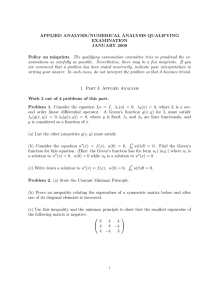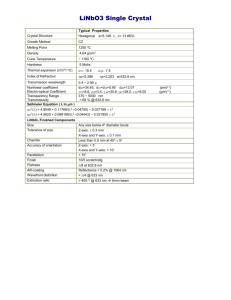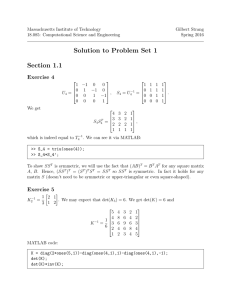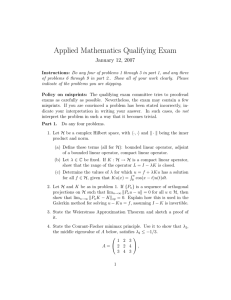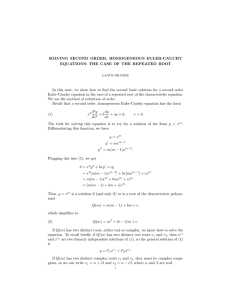POSITIVE SOLUTIONS OF ELLIPTIC EQUATIONS IN TWO-DIMENSIONAL EXTERIOR DOMAINS
advertisement
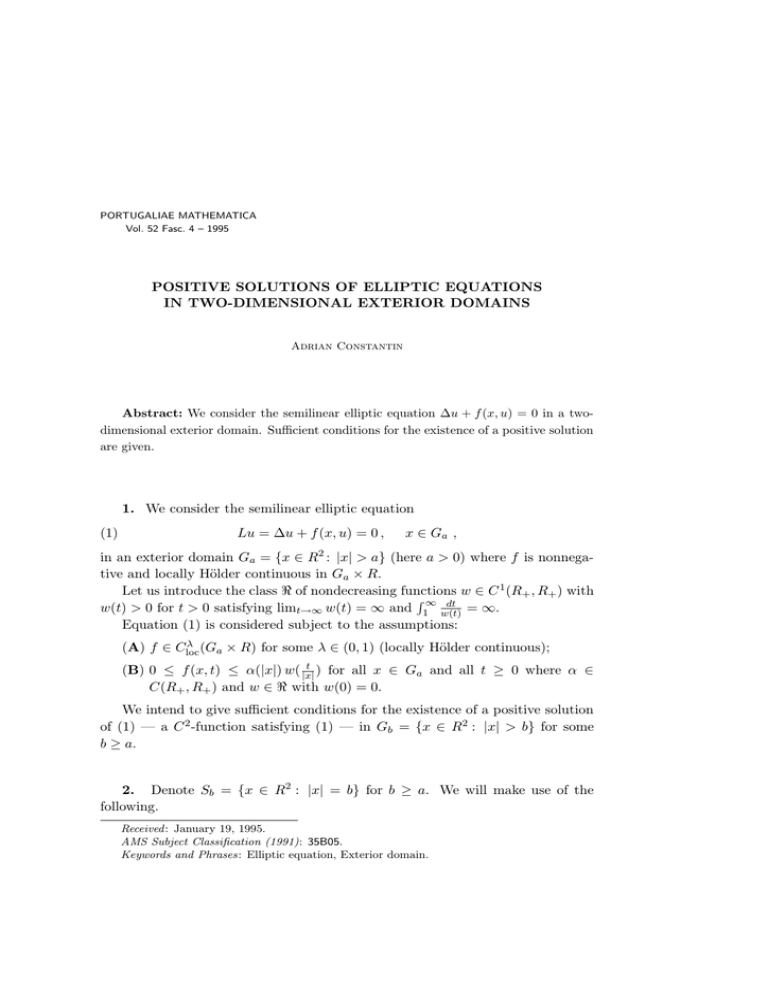
PORTUGALIAE MATHEMATICA
Vol. 52 Fasc. 4 – 1995
POSITIVE SOLUTIONS OF ELLIPTIC EQUATIONS
IN TWO-DIMENSIONAL EXTERIOR DOMAINS
Adrian Constantin
Abstract: We consider the semilinear elliptic equation ∆u + f (x, u) = 0 in a twodimensional exterior domain. Sufficient conditions for the existence of a positive solution
are given.
1. We consider the semilinear elliptic equation
(1)
Lu = ∆u + f (x, u) = 0 ,
x ∈ Ga ,
in an exterior domain Ga = {x ∈ R2 : |x| > a} (here a > 0) where f is nonnegative and locally Hölder continuous in Ga × R.
Let us introduce the class < of nondecreasing functions w ∈ C 1 (R+ , R+ ) with
R
dt
w(t) > 0 for t > 0 satisfying limt→∞ w(t) = ∞ and 1∞ w(t)
= ∞.
Equation (1) is considered subject to the assumptions:
λ (G × R) for some λ ∈ (0, 1) (locally Hölder continuous);
(A) f ∈ Cloc
a
t
) for all x ∈ Ga and all t ≥ 0 where α ∈
(B) 0 ≤ f (x, t) ≤ α(|x|) w( |x|
C(R+ , R+ ) and w ∈ < with w(0) = 0.
We intend to give sufficient conditions for the existence of a positive solution
of (1) — a C 2 -function satisfying (1) — in Gb = {x ∈ R2 : |x| > b} for some
b ≥ a.
2. Denote Sb = {x ∈ R2 : |x| = b} for b ≥ a. We will make use of the
following.
Received : January 19, 1995.
AMS Subject Classification (1991): 35B05.
Keywords and Phrases: Elliptic equation, Exterior domain.
472
A. CONSTANTIN
Lemma [2]. Let L be the operator defined by (1) where f is nonnegative
and satisfies assumption (A) in Ga . If there exists a positive solution u1 and a
nonnegative solution u2 of Lu1 ≤ 0 and Lu2 ≥ 0, respectively, in Gb (b ≥ a)
such that u2 (x) ≤ u1 (x) throughout Gb ∪ Sb , then equation (1) has at least one
solution u(x) satisfying u(x) = u1 (x) on Sb and u2 (x) ≤ u(x) ≤ u1 (x) throughout
Gb .
We prove now
Theorem. Assume that (A), (B) hold and that
Z
(2)
∞
r α(r) dr < ∞ .
a
Then there is a b ≥ a such that (1) has a positive solution in Gb .
Proof: We consider the nonlinear differential equation
(3)
d
dy
r
dr
dr
½
¾
+ r α(r) w
µ
y
l n(r)
¶
= 0,
r≥e,
where we define w(−y) = −w(y) for y ≥ 0 (we can extend w this way since
w(0) = 0). As one can easily check, the so-defined w belongs to C 1 (R, R).
Liouville’s transformation r = es , h(s) = y(es ) changes (3) into
(4)
h(s)
h (s) + e α(e ) w
s
00
2s
s
µ
¶
= 0,
s≥1.
Let us show that equation (4) has a solution h(s) which is positive in [c, ∞)
for some c ≥ 1.
Hypothesis (2) guarantees (see [1]) that for every solution h(s) of (4) there
exist real constants m, l such that h(s) = m s + l + o(s) as s → ∞ (m =
lims→∞ h0 (s)). We will show that any nontrivial solution h(s) of (4) is of constant
sign for s in a neighbourhood of ∞ and since w is odd on R, this gives a solution
of (4) which is positive in [c, ∞) for some c ≥ 1.
Assume that there is a nontrivial solution h(s) of (4) which has a strictly
increasing sequence of zeros {sn }n≥1 accumulating at ∞. Then we have that the
corresponding m, l are both equal to 0, i.e. lims→∞ h(s) = lims→∞ h0 (s) = 0.
Denote
K = sup{|h(s)|} > 0 , M = sup {|w0 (u)|} > 0
s≥1
|u|≤K
and observe that |w(u)| ≤ M |u| for |u| ≤ K (by the mean-value theorem since
w(0) = 0).
POSITIVE SOLUTIONS OF ELLIPTIC EQUATIONS
473
Since limn→∞ sn = ∞ and a∞ r α(r) dr < ∞, there exists an n0 such that
1
2s
s
0
sn0 e α(e ) ds < M . The relation h(sn0 ) = 0 implies |h (sn0 )| > 0 (we have
local uniqueness for the solutions of (4) since w ∈ C 1 (R, R) so that h(sn0 ) =
h0 (sn0 ) = 0 would imply h(s) = 0 for all s ≥ 1) and since lims→∞ h0 (s) = 0, there
is a root sn1 of h(s) with |h0 (s)| < 12 |h0 (sn0 )| for s ≥ sn1 . Let T ∈ [sn0 , sn1 ] be
such that |h0 (s)| attains its maximal value on this interval at T .
Since |h0 (T )| is by construction equal to supsn0 ≤s {|h0 (s)|}, we have by the
mean-value theorem that
R
R∞
¯
¯
¯
¯
|h(s)| = ¯h(s) − h(sn0 )¯ ≤ (s − sn0 ) |h0 (T )| ,
and we obtain
|h(s)|
≤ |h0 (T )| ,
s
Integrating (4) on [T, s] (T < s), we get
0
0
h (s) − h (T ) +
Z
s
e
2τ
T
thus
|h0 (T )| ≤ |h0 (s)| +
Z
s n0 ≤ s ,
s n0 ≤ s .
|h(τ )|
α(e ) w
dτ = 0 ,
τ
∞
τ
µ
¶
e2τ α(eτ ) w
T
µ
|h(τ )|
dτ ,
τ
¶
T ≤s,
T ≤s.
Letting s → ∞ (remember that lims→∞ h0 (s) = 0) we get, in view of the previous
remarks,
|h0 (T )| ≤
Z
∞
e2τ α(eτ ) w
T
≤ M |h0 (T )|
µ
Z
|h(τ )|
dτ ≤ M
τ
∞
¶
Z
∞
e2τ α(eτ )
T
e2τ α(eτ ) dτ ≤ M |h0 (T )|
T
Z
|h(τ )|
dτ ≤
τ
∞
e2τ α(eτ ) dτ < |h0 (T )| ,
sn 0
a contradiction which shows that equation (4) has a solution h(s) which is positive
in [c, ∞) for some c ≥ 1.
To this solution there corresponds a solution y(r) of (3), defined for r ≥ e and
that is positive on [ec , ∞).
Let us define u1 (x) = y(r), r = |x| ≥ b = max{a, ec }. We have
d
r
dr
½
d
≤
r
dr
½
d
≤
r
dr
rLu1 (x) =
½
dy
+ r f (x, u1 (x))
dr
¾
µ
¶
y(r)
dy
+ r α(r) w
dr
r
¾
µ
¶
dy
y(r)
+ r α(r) w
= 0,
dr
l n(r)
¾
r≥b,
474
A. CONSTANTIN
so that Lu1 (x) ≤ 0 for all x ∈ Gb . Clearly u2 (x) = 0 satisfies Lu2 (x) ≥ 0 in
Gb . The Lemma shows that (1) has a solution u(x) in Gb with 0 ≤ u(x) ≤
u1 (x) = y(r) for |x| = r > b and u(x) = u1 (x) > 0 for |x| = b. Let now
d > b. Since u(x) ≥ 0 for |x| = d > b, by the maximum principle (∆u(x) ≤ 0 in
{x ∈ R2 : b < |x| < d}) we get that u(x) > 0 for b < |x| < d. This shows (d > b
was arbitrary) that u(x) is a positive solution of (1) in Gb .
3. To show the applicability of our result and its relation to other similar
results from the literature ([2], [3], [4]) we consider the following
Example: The semilinear elliptic equation
∆u +
u
u
+ 1 = 0,
ln
|x|4
|x|
µ
¶
|x| > 1 ,
has a positive solution in Gb for some b ≥ 1.
Indeed, we can apply our theorem with α(r) = r13 for r ≥ 1 and w(s) =
s l n(s + 1), s ≥ 0. We cannot apply the results of [2], [3] or [4] since it is
λ (R × R ) with g(r, t) nonincreasing of t in
impossible to find a function g ∈ Cloc
+
+
R+ for each fixed r > 0, such that f (t, x) ≤ tg(|x|, t), |x| > 1, t ≥ 0.
REFERENCES
[1] Constantin, A. – On the asymptotic behaviour of second order nonlinear differential equations, Rend. Mat. Roma, 13 (1993), 627–634.
[2] Noussair, E.S. and Swanson, C.A. – Positive solutions of quasilinear elliptic
equations in exterior domains, J. Math. Anal. and Appl., 75 (1980), 121–133.
[3] Swanson, C.A. – Criteria for oscillatory sublinear Schrödinger equations, Pacific
J. Math., 104 (1983), 483–493.
[4] Swanson, C.A. – Positive solutions of −∆u = f (x, u), Nonlinear Analysis, 9
(1985), 1319–1323.
Adrian Constantin,
Courant Institute of Mathematical Sciences,
251 Mercer Street, 10012 New York – USA
